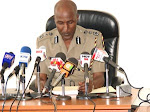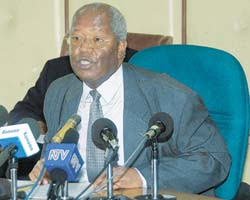NAIROBI, Kenya — Ethnically driven violence intensified in Kenya on Sunday, and police officials said at least 19 people, including 11 children, were burned to death in a house by a mob.
Even the Kenyan military, deployed for the first time to stop antagonists from attacking one another, has been unable to halt the wave of revenge killings.
More than 100 people have been killed in the past four days, many of them shot with arrows, burned or hacked with machetes.
It is some of the worst fighting since a disputed election in December ignited long-simmering tensions that have so far claimed at least 750 lives. The fighting appeared to be spreading Sunday across the Rift Valley region, a particularly picturesque part of Kenya known more for its game parks and fancy lodges.
The Kenyan government is now threatening to arrest top opposition leaders on suspicion of orchestrating the bloodshed, but opposition leaders are in turn accusing the government of backing criminal gangs.
According to police officials in the Rift Valley town of Naivasha, fighting erupted Sunday morning between gangs of Kikuyus and Luos, two of Kenya’s biggest ethnic groups, who have clashed across the country since the election. Witnesses said mobs threw flaming tires and mountains of rocks into the streets to block police officers from entering some neighborhoods. The mobs then went house to house, looking for certain people.
Grace Kakai, a police commander in Naivasha, said a large crowd of Kikuyus chased a group of Luos through a slum, trapped them in a house, blocked the doors and set the house afire. Police found 19 bodies huddled in one room, and Ms. Kakai said some of the children’s bodies were so badly burned that they could not be identified.
“All I can say is that they were school age,” she said.
The episode was similar to one on Jan. 1, when up to 50 women and children seeking shelter in a church in another Rift Valley town were burned to death by a mob. The victims in that case were mostly Kikuyus, and Kikuyus across the country seem to have been attacked more than any other group.
In the past few days, many Kikuyus have organized into militias, saying they are now ready for revenge.
“The situation is very bad,” Ms. Kakai said. “People are fighting each other and trying to drive them out of the area. We have to evacuate people.”
Thousands of families are streaming out of Naivasha, Nakuru, Molo, Eldoret and other towns across the Rift Valley, which has become the epicenter of Kenya’s violence. The province is home to supporters of both Mwai Kibaki, Kenya’s president, and Raila Odinga, the top opposition leader, and the site of historic land disputes between members of rival ethnic groups.
Mr. Kibaki is a Kikuyu and Mr. Odinga is a Luo, and the disputed election, in which Mr. Kibaki was declared the winner by a narrow margin despite widespread evidence of vote rigging, set off the ethnically driven violence.
The Kenya of today is almost unrecognizable compared with the Kenya that until recently was celebrated as one of the most stable and promising countries on the African continent. On Sunday night, local television stations showed menacing young men waving machetes and iron bars at roadblocks along one of the country’s busiest highways. The men threw rocks at buses, with one large bus run off the road, as police officers stood by.
The Kenyan Army was assigned early this month to help evacuate people from conflict zones, but on Friday, for the first time, soldiers were ordered to intervene between warring groups. That did not seem to make much of a difference, and witnesses said the soldiers had been as ineffective as the police.
A dusk-to-dawn curfew has been imposed in several Rift Valley towns, including Naivasha and Nakuru, but witnesses said violence continued to rage in the countryside, with bands of armed men burning down huts and attacking ethnic rivals.
Many Kenyans have said the most distressing aspect is that the opposing politicians, instead of cooperating to stop the bloodshed, continue to bicker over who started it.
That is exactly what happened on Sunday after news of the Naivasha killings spread. Salim Lone, Mr. Odinga’s spokesman, sent out a cellphone message calling the killings “ghastly” and saying that they were the work of criminal gangs backed by police officers and “part of a well orchestrated plan of terror.”
“The government is doing this to try to influence mediation efforts,” the message said, referring to the continuing but so far fruitless negotiations led by Kofi Annan, the former secretary general of the United Nations. “After stealing the elections from Kenyans, Kibaki now wishes to deny them justice and peace.”
Alfred Mutua, a government spokesman, called the accusations “ridiculous.”
“What is really happening is a continuation of the ethnic cleansing that Raila’s people are doing to kill the president’s people,” he said.
Mr. Mutua said the violence would stop “when we indict the leaders responsible for this.”
“We are working on indictments,” he said Sunday night. “That will happen very soon.”
Western diplomats have said there is a debate raging within Mr. Kibaki’s inner circle about the wisdom of arresting top opposition figures, with some advisers pushing for it, while others fear that the violence will only get worse if the leaders are jailed because their supporters will go on an even more intense rampage.
Kenyan newspapers reflected the gloom. “For the umpteenth time, we again ask President Kibaki and Orange Democratic Movement leader Mr. Raila Odinga to work for peace, truth and justice,” said an editorial in The Sunday Standard. “Kenya has bled enough.”
















|